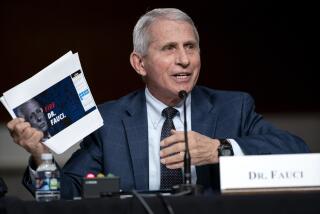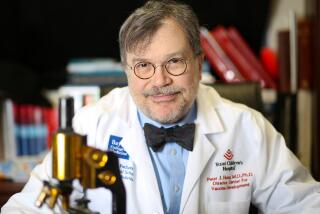BioWatch stands at a crossroads
WASHINGTON -- Year after year, health officials meeting at invitation-only government conferences leveled with one another about BioWatch, the nation’s system for detecting deadly pathogens that might be unleashed into the air by terrorists.
They shared stories of repeated false alarms -- mistaken warnings of germ attacks from Los Angeles to New York City. Some questioned whether BioWatch worked at all.
They did not publicize their misgivings. Indeed, the sponsor of the conferences, the U.S. Homeland Security Department, insists that BioWatch’s operations, in more than 30 cities, be kept mostly secret.
Now, congressional investigators want Homeland Security Secretary Janet Napolitano to open the books on the 9-year-old program and explain why $3.1 billion in additional spending is warranted.
The move by the House Energy and Commerce Committee -- spurred by reports in the Los Angeles Times about BioWatch’s deficiencies -- puts the program at a crossroads.
On one side is mounting evidence that the technology does not work. On the other are companies eager to tap federal contracts, politicians fearful of voting against any program created to fight terrorism, and a top Homeland Security official who says the program is functioning properly.
Government records show that BioWatch signaled attacks more than 100 times when none had occurred. Nor is the system sensitive enough to reliably detect low yet infectious concentrations of pathogens such as anthrax, smallpox or plague, according to specialists familiar with test results and computer modeling. Another defect is BioWatch’s inability to distinguish between particular pathogens that are genetically similar but benign.
Lab and field tests found similar problems in the latest technology intended for BioWatch, “Generation 3.” The congressional investigators are seeking internal documents illuminating BioWatch’s performance, plus the private comments of Napolitano’s top science and technology advisor, Dr. Tara O’Toole, who recommended killing Generation 3.
O’Toole’s skepticism is shared by Dr. Donald A. Henderson, a renowned epidemiologist who led the global eradication of smallpox. Henderson, a federal anti-terrorism advisor when BioWatch was launched in 2003, says he has yet to see a “scientific justification” for it.
“It has never stood the test of rationality,” Henderson said. “This whole concept is just preposterous.”
Political ties
But as Napolitano weighs whether to deploy Generation 3 -- at the cost of $3.1 billion over its first five years -- the program will not be easy to scale back.
The company in line to install Generation 3, Northrop Grumman Corp., is a major donor to federal campaigns with a broad presence in Washington.
From 2004 to 2012, the company’s political action committee gave more than $6 million to congressional candidates, campaign finance records show. Northrop Grumman, a top defense contractor, ranked No. 10 this year among all PAC donors to congressional campaigns.
Northrop Grumman also hired the former head of BioWatch, Dr. Jeffrey W. Runge, as an advisor to assist its pursuit of the Generation 3 contract.
On Sept. 27, Runge told invitees to the Harvard Faculty Club that a survey he designed for what he called “homeland security related professionals” had found support for deploying the new technology, regardless of potential shortcomings.
Rather than wait for more research to refine Generation 3, Runge told the gathering, “the respondents seem to be saying ... ‘Deploy the detectors, even if they can’t pick up every intentional pathogen or genetic variation, and deal with the problems later.’ ”
Runge, who provided his prepared remarks to The Times, said Northrop Grumman solicited his advice a few months after he left the government in 2008 and paid him an hourly rate. The arrangement ended in summer 2009, he said.
Runge said the company paid him to explain how the Homeland Security Department “is thinking, how Congress is thinking, about the future of biodetection.” Among those he briefed, Runge said, was Northrop Grumman’s project manager for Generation 3.
In 2010 and 2011, Northrop Grumman donated a total of $100,000 to the Heritage Foundation, a conservative research group, which, beginning in July, circulated three commentaries supporting federal funding for BioWatch and Generation 3. The donations were disclosed in the group’s annual reports.
Steven P. Bucci, a Heritage Foundation senior fellow, wrote on July 11, “BioWatch is far from an ‘unnecessary expenditure.’ Congress should thus continue to fund the program.”
The third Heritage essay, issued Dec. 12 and also written by Bucci, said that although BioWatch was “only marginally effective,” Napolitano and President Obama should stay the course. “Cutting funding to this project,” he wrote, “leaves us vulnerable in a way that will cripple our future security.” Bucci said his writings were his own.
Asked for comment, a spokesman for Northrop Grumman, Brandon R. Belote III, said the company “recognizes the importance of participating in the democratic process.”
For politicians determined to appear resolute against terrorism, fully funding BioWatch might carry less risk than scaling it back.
“If somebody cancels the program, and a week later there’s a release, they’ll never, ever recover from making that decision,” said George Mason University microbiologist Stephen Prior, co-author of a 2004 National Defense University study of BioWatch. “If they don’t make that decision, they can’t be wrong.”
Meanwhile, the Homeland Security Department’s chief medical officer, Dr. Alexander Garza, has assured Congress that BioWatch is performing effectively. In March, Garza told a House subcommittee that the Generation 3 system was “right where it needs to be,” but he did not cite the deficiencies found by the tests of prototype sensors.
On Sept. 13, Garza told another congressional hearing that, in his view, none of the existing system’s mistaken detections of benign organisms as lethal pathogens were false alarms. Though each of the laboratory-confirmed results signaled potential terrorist attacks, Garza asserted that they were not false alarms because authorities never ordered evacuations or other emergency measures.
The panel voiced concerns about BioWatch. No one, however, pressed Garza to explain his basis for defending BioWatch’s misidentifications of the harmless organisms. Nor did they question Garza about the system’s poor sensitivity.
Eroded confidence
When he announced the program in his 2003 State of the Union address, President George W. Bush said BioWatch would “protect our people and our homeland.” He called it “the nation’s first early-warning network of sensors to detect biological attack.”
BioWatch units placed in public places suck air through composite filters all day and night. Once every 24 hours, the filters are delivered to public health laboratories, where technicians search for the DNA of the targeted pathogens. Under Generation 3, BioWatch would be converted to automated sensors, each a “lab in a box,” designed to both capture and test samples of air.
The first false alarms occurred soon after BioWatch’s deployment, demonstrating that it could not distinguish between the most commonly signaled pathogen, tularemia, and “near-neighbor” organisms that pose no life-threatening harm.
Previously unpublicized Homeland Security materials show that the Houston area alone racked up more than 30 false alarms as of mid-2008, nearly all for the germ that causes tularemia, also known as rabbit fever.
The many false alarms nationwide -- including results that caused tense deliberations among health officials at the 2008 Democratic National Convention and at championship sporting events -- have eroded confidence in the system.
Local, state and federal officials faced with a BioWatch alarm have not once evacuated an area or dispensed emergency medicine. They have instead monitored hospitals in search of potential victims before deciding to disregard the alarms, a wait-and-see approach counter to the rationale for BioWatch.
The Homeland Security Department’s emphasis on keeping the details quiet is reinforced at the annual BioWatch conferences, according to attendees and government documents. The 2008 conference included workshops such as “Loose Lips Sink Collectors! Managing Media Inquiries about BioWatch,” and “Psychology of Press Releases.”
Last month, leaders of the House Energy and Commerce Committee said Homeland Security had withheld key documents that the panel had asked for in July. In a letter to Napolitano, the committee said the episode raised “serious questions about the department’s willingness to cooperate.”
The department has pledged cooperation, and Napolitano, a former governor of Arizona, has delegated the public defense of BioWatch to Garza, also a presidential appointee. Garza has said that scientists are working “to improve BioWatch to keep the nation safe from any potential biological threats.”
In recent interviews, more than a dozen specialists who have worked with or examined BioWatch said it should be independently assessed, and scaled back or dismantled.
Dr. Arthur L. Kellermann, a physician and public health researcher at Rand Corp. who studied BioWatch from 2007 to 2009 as a member of a National Academy of Sciences committee, said it “has generated nothing but false alarms.”
Kellermann and other specialists said the money spent on BioWatch could have paid for training and equipment to help medical professionals more quickly diagnose a patient exposed to an attack. The many false alarms, they said, invite complacency.
“After you hear a certain amount of car alarms in your neighborhood, you stop worrying about them,” Kellermann said.
More to Read
Sign up for Essential California
The most important California stories and recommendations in your inbox every morning.
You may occasionally receive promotional content from the Los Angeles Times.











